Even the best design, implementation and verification are worthless if they are the solution to the wrong problem. Defining the problem properly is the task of requirements, also known as business analysis. To be successful, a project must apply to requirements the same engineering standards as to other parts of system construction.
The Handbook presents a holistic view of requirements including four elements or PEGS: Project, Environment, Goals and System. One of its principal contributions is the definition of a Standard Plan for requirements documents, consisting of the four corresponding books and replacing the structure of the obsolete IEEE 1998 standard.
The text covers both classical requirements techniques and advanced topics. The successive chapters address:fundamental concepts and definitions; requirements principles; the Standard Plan for requirements; how to write good requirements; how to gather requirements; scenario techniques (use cases, user stories); object-oriented requirements; how to take advantage of formal methods; abstract data types; and the place of requirements in the software lifecycle.
The Handbook is suitable both as a practical guide for industry and as a textbook, with over 50 exercises and supplementary material available from the book’s site, including slides and links to video lectures (MOOCs).
Even the best design, implementation and verification are worthless if they are the solution to the wrong problem. Defining the problem properly is the task of requirements, also known as business analysis. To be successful, a project must apply to requirements the same engineering standards as to other parts of system construction.
The Handbook presents a holistic view of requirements including four elements or PEGS: Project, Environment, Goals and System. One of its principal contributions is the definition of a Standard Plan for requirements documents, consisting of the four corresponding books and replacing the structure of the obsolete IEEE 1998 standard.
The text covers both classical requirements techniques and advanced topics. The successive chapters address:fundamental concepts and definitions; requirements principles; the Standard Plan for requirements; how to write good requirements; how to gather requirements; scenario techniques (use cases, user stories); object-oriented requirements; how to take advantage of formal methods; abstract data types; and the place of requirements in the software lifecycle.
The Handbook is suitable both as a practical guide for industry and as a textbook, with over 50 exercises and supplementary material available from the book’s site, including slides and links to video lectures (MOOCs).

Handbook of Requirements and Business Analysis
250
Handbook of Requirements and Business Analysis
250Paperback(1st ed. 2022)

Product Details
| ISBN-13: | 9783031067389 |
|---|---|
| Publisher: | Springer International Publishing |
| Publication date: | 07/31/2022 |
| Edition description: | 1st ed. 2022 |
| Pages: | 250 |
| Product dimensions: | 7.01(w) x 10.00(h) x (d) |
